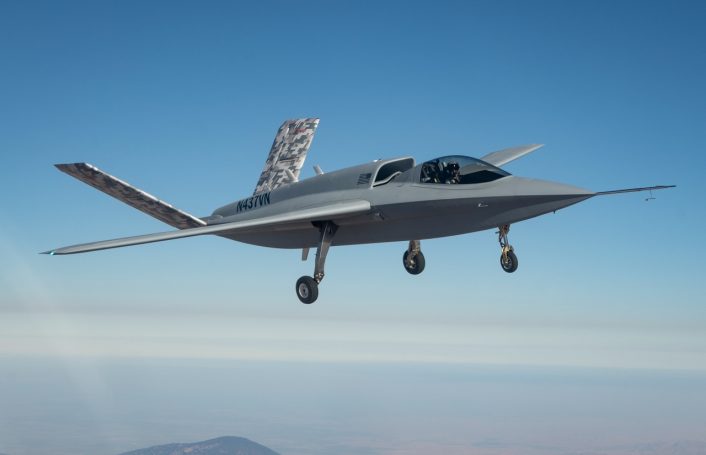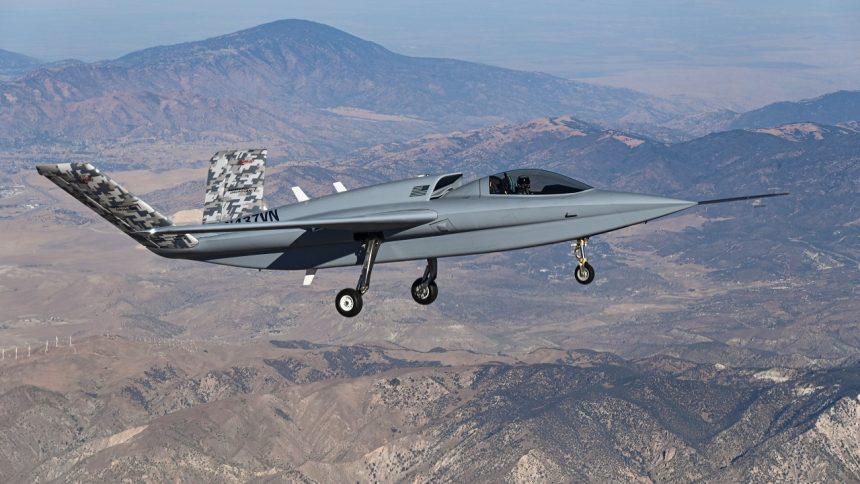Developed as an unmanned loyal wingman, the Model 437 performed the first flight with a cockpit and Scaled Composites’ Brian Maisler at the commands.
The new Model 437 aircraft by Scaled Composites, the well-known cutting-edge aerospace company famous for its many exotic aircraft, has flown for the first time on Aug. 29, 2024. The aircraft, which has been named Vanguard (and this is referenced also in the registration N437VN), took off from the company facilities at the Mojave Air and Space Port, California.
Built in partnership with the parent company Northrop Grumman, the Model 437 was seen for the first time earlier this month as it was being towed in the airport. Until then, the Model 437 was known through the official rendering as an unmanned aircraft, so it came as a surprise to many when it was discovered that the aircraft has a cockpit.
One of first aspects that many noticed was the similarity to one of the company’s earlier designs, the Model 401. This has now also been confirmed by Scaled Composites, which said in the first flight’s press release that Model 437 began as a conceptual design based on the Model 401, exploring a multi-mission low-cost attritable aircraft.
Here is a description of the design provided by the company:
The Model 437 Vanguard is a crewed variant of the original concept powered by a single Pratt & Whitney 535 engine with approximately 3,400 pounds of thrust. The aircraft has a wingspan of 41 feet and is 41 feet long with a gross takeoff weight of 10,000 pounds. After completion of envelope expansion, the M437 Vanguard will have a range of approximately 3000 nautical miles and an endurance of 6 hours. The aircraft can carry up to 2,000 pounds of payload in multiple locations including an internal weapons bay sized to accommodate two AIM-120s.
Scaled is excited to share that this morning we conducted the first flight of the Model 437 Vanguard, demonstrating @northropgrumman‘s Digital Pathfinder wings with test pilot Brian Maisler in command. Learn more at https://t.co/fUqOQUD34V#FirstFlight #FlightTest #M437Vanguard pic.twitter.com/0w4HkJtN9c
— Scaled Composites (@ScaledC) August 29, 2024
Scaled Composites said they leveraged extensive experience in rapid design, fabrication, and test of experimental aircraft to develop the Model 437. Their work, as mentioned in the press release, included a clean sheet aircraft design, aerodynamic and structural analysis, fuselage and empennage fabrication, aircraft assembly, systems integration, and ground and flight test execution.
Northrop Grumman, on the other hand, defined, developed, built and verified the removable wing assemblies using advanced digital tools and processes as part of their Digital Pathfinder effort. The company noted that this project demonstrated how their fully digital engineering ecosystem “reduces engineering rework, accelerates schedule and reduces costs, offering advantages to customers on future aircraft programs.”
The press release further noted the use of real-world experiences gained on programs, and notably mentioned the experience from the B-21 Raider stealth bomber. “The digital ecosystem cut engineering rework and redesign to less than one percent, compared to the 15-20% experienced using traditional methods,” added Northrop Grumman.

The Model 437
The first concept arts of the Model 437 were unveiled in 2021, with the unmanned design envisioned to work alongside manned aircraft as a “loyal wingman”. At that time, Aviation Week said the aircraft was expected to have a range of about 3,000 nautical miles, with a fuel load of 4,000 pounds of fuel and a cruise speed of around 0.8 Mach.
A couple of AIM-120 AMRAAM missiles or a side-looking radar were expected as possible payloads. All these characteristics appear to fall roughly in line with what was divulged today by Scaled Composites after the first flight.
I’ve seen two versions of the 437 render, one looking a lot more like an unmanned Model 401, and the one on the right which looks to be the more finalized design
Still very reminiscent of the 401 w/ the lamda wings and ruddervators, but much less dihedral on the wings pic.twitter.com/Fo41CfySM0
— TaskForce23 (@Task_Force23) August 9, 2024
Honestly if the canopy were removed, the overall shape matches the right render pretty closely
Also interesting is the camo pattern on the ruddervators pic.twitter.com/P2to8ZzFnZ
— TaskForce23 (@Task_Force23) August 9, 2024
The same can be said for the shape of the design which, as mentioned, is derived from the Model 401. The Model 437 features swept wings with trapezoidal inner sections near the wing root and a V-tail, all combined with a seemingly semi-trapezoidal fuselage. Notably, the V-tail shows a digital camouflage pattern.
The air inlet is on the top of the fuselage, immediately behind the cockpit. As for the P&W 535 engine’s outlet, the aircraft is equipped with a simple round exhaust. Also, in the front, there is the standard air data probe installed for the test flights of new designs.
The Model 401
The Model 401 Sierra project was developed as clean sheet design for a low-cost manufacturing technology demonstrator aircraft, flown by a single pilot, powered by a single turbofan, and operating at medium altitudes, with two identical vehicles being built. Development took only 24 months from initial concept to the first flight for the first Model 401 in October 2017, followed six months later by the second aircraft.
As a reference to Scaled Composites’ earlier Agile Responsive Effective Support (ARES) test jet, the two Model 401s are also known as “Sons of Ares”, which is the god of war in Greek mythology. The two aircraft have been therefore further nicknamed Phobos and Deimos, sons of Ares and gods of fear and terror, respectively. The nicknames are also reflected by the registrations of the two jets, N401XP and N401XD, respectively.
The Model 401, also known as Sierra by the company, is one of the most mysterious aircraft currently being used for flight testing outside of the military. Following initial performance envelope expansion, both aircraft started to conduct payload development testing for a wide variety of customers.
In fact, as stated by Scaled Composites, the aircraft are able to incorporate a diverse range of payload systems with over 80 cubic feet of internal payload volume and up to 2,000 pounds of payload weight capacity. Among these there might be a laser directed energy system, as seen in 2022 with a pod installed under the fuselage marked with an art seemingly referring to a laser.
We can’t rule out the possibility of test flights for the research of new capabilities to protect an aircraft against directed energy weapons. Let’s not forget that a Model 401 was the first aircraft to be spotted with a mirror-like coating two years earlier, before similar coatings appeared on F-22s, F-35As and F-35Cs, and F-117s working with the U.S. Air Force and Navy test and evaluation units.









